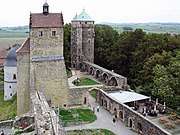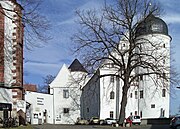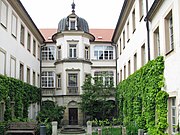Meissen Abbey
The Meissen bishopric was the territorial property of the bishop and the cathedral chapter of Meissen. The Meissner Bishop was this territory regent of a clergyman kingdom principality in the Holy Roman Empire . He ruled this imperial area, which was not identical or even spatially congruent with his church district, the diocese of Meißen , as a spiritual prince of the empire . The Hochstift still exists today as a corporation under public law and is administered as a monastery of the Evangelical Lutheran Regional Church of Saxony by the cathedral chapter under the leadership of the Evangelical regional bishop.
history
The Hochstift was founded together with the Meißen diocese in 968, making it the oldest institution in Saxony . Since the founding of the diocese, the bishops resided in the bishop's castle on the Meißner Burgberg, which they shared with the margraves and burgraves of Meißen. Instead of the early medieval Margrave Castle, the new Albrechtsburg was built around 1480 and the Burggrafenburg fell into disrepair. Stolpen Castle has been the bishops' headquarters since the beginning of the 15th century .
Among the numerous donations that the diocese in Saxony and Upper Lusatia had received from the kings and margraves, the properties in the Wurzen area (the Wurzen collegiate monastery with the Wurzener Land ) and in the Stolpen - Bischofswerda area were of outstanding importance. In these two areas, the bishops and the cathedral chapter succeeded in the 14th century in consolidating their numerous rights and possessions to such an extent that they effectively became sovereigns there. However, the status of imperial immediacy was always denied to the bishops by the powerful Meissen margraves . Therefore, the Meissen bishops were only rarely represented as spiritual princes in the Imperial Council of the Reichstag .
From 1491 they built Wurzen Castle , and in Bischofswerda they also maintained a bishopric, which in its current form was not rebuilt until 1818 after a city fire. The Meißner Bischofsburg now serves as the district court.
Bishopric in Bischofswerda
In 1559, the last bishop of Meissen had to cede the offices of Stolpen and Bischofswerda to the Elector of Saxony. After the Reformation was introduced in Saxony, the entire bishopric became Evangelical-Lutheran in 1581. With the resignation of the last bishop, Johann IX. Haugwitz , 1581 that were Wurzener country and the offices Mügeln and Sornzig completely into the since 1547 Albertine Electorate incorporated, even if it as a pen Office Wurzen until 1818 by a specially created "Electoral Saxon pin Government" ( by the prescribed of the pin Meissen Captain , Chancellor and Councilors ) was administered on behalf of the Dresden court.
Essentially only the Meissen Cathedral and some of the surrounding area remained for the Hochstift . However, it still exists today and is currently a monastery of the Evangelical Lutheran Church of Saxony and a corporation under public law . It has its seat in the Dompropstei Meißen . The canon is the respective Saxon regional bishop . Today the Meissen Monastery functions as an institution for the maintenance of the Meissen Cathedral and the other associated buildings and properties and for the administration of its assets. It is responsible for the Evangelical Lutheran church service in the cathedral and the organization of Protestant life in the cathedral district. It ensures that the cathedral is accessible to the public as a monument.
The bishopric is legally represented by the cathedral chapter . It consists of eight ordinary canons ( provost , dean , senior, sub-senior and four other canons). Dompropst is currently Superintendent Andreas Stempel, dean is Uwe Schirmer . The cathedral chapter usually meets twice a year. The canons wear regalia in the service . The administration is carried out by the Stiftssyndikus. The main professional employees of the bishopric are cathedral choirmasters, cathedral sextons and administrative staff; part-time they are cathedral priests, cathedral preachers, monastery syndicates and cathedral builders.
See also
Individual evidence
- ↑ The Hochstift Meißen. In: Dom-zu-Meissen.de. Retrieved December 12, 2013 .





